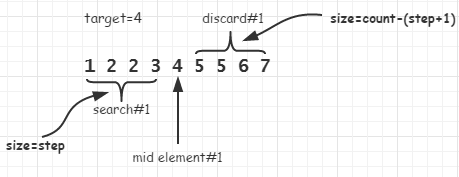C++ STL:lower_bound与upper_bound实现
lower_bound
lower_bound(begin, end, target)用来查找一个已排序的序列中[begin, end)第一个大于等于target的元素index。数组A如下:
value: 1, 2, 2, 3, 4, 5, 5, 6, 7
index: 0, 1, 2, 3, 4, 5, 6, 7, 8
这样的一个序列,如果查找5的lower_bound,返回的应该是第一个5即A[5]。下面是摘自cplusplus.com上的lower_bound代码
template <class ForwardIterator, class T>
ForwardIterator lower_bound (ForwardIterator first, ForwardIterator last, const T& val)
{
ForwardIterator it;
iterator_traits<ForwardIterator>::difference_type count, step;
count = distance(first,last);
while (count>)
{
it = first; step=count/; advance (it,step);
if (*it < val) { // or: if (comp(*it,val)), for version (2)
first = ++it;
count -= step+;
}
else count = step;
}
return first;
}
如果搜索对象只是数组的话还可以再简化一点:
count = last - start;
while (count > ) {
step = count/;
int* it = first + step;
if (*it < target) {
count = count - (step + );
first = it + ;
} else {
count=step;
}
}
return first;

基本情况: 当输入只有一个元素时,而该元素不是要查找的元素时返回last,即该元素的后一个位置
case: target=4
当在上图中的数组中找4的lower_bound时,第一次*it取到的值是4,因为这不是简单的二分搜索,而是要返回第一大于等于查找元素的位置,所以搜索不能在此时结束。但是可以确定5~7这一部分可以不用搜索了,因为当前至少有一个元素即*it是大于等于4了,因而缩小查找范围(count=step)。这个查找范围并不包括已找到的4,为什么是这样?分情况讨论:
1. 当前面的这个范围没有符合条件的数时,就会将范围最后的位置的后一位置返回,而此位置正好是4所在的位置(*it>= target时it所在的位置,它是符合查找条件的),其正好是lower_bound。
2. 当前面的这个方位含有符合条件的数时,此时当前的这个4就不是lower_bound,真正的lower_bound会在该区间内产生
case: target=5
当求5的lower_bound时,第一次找到中间元素时4,4<5,所以4和4前面的所有都不会含有5的lower_bound,因而下一次搜索只会在5~7这个区间进行,这个就和一个全新的问题一样了。
upper_bound
upper_bound用来在[begin, end)中找到第一个大于target的index
template <class ForwardIterator, class T>
ForwardIterator upper_bound (ForwardIterator first, ForwardIterator last, const T& val)
{
ForwardIterator it;
iterator_traits<ForwardIterator>::difference_type count, step;
count = std::distance(first,last);
while (count>)
{
it = first; step=count/; std::advance (it,step);
if (!(val<*it)) // or: if (!comp(val,*it)), for version (2)
{ first=++it; count-=step+; }
else count=step;
}
return first;
}
简化版本:
lower_bound:
int lo = , hi = n;
// lower_bound
while (lo < hi) {
int mid = (lo + hi) / ;
if (A[mid] < target) {
lo = mid + ;
} else {
hi = mid;
}
} return lo;
upper_bound:
lo = , hi = n;
// upper_bound
while (lo < hi) {
int mid = (lo + hi) / ;
if (A[mid] <= target) {
lo = mid + ;
} else {
hi = mid;
}
}
return lo;
就在判断条件上多了个等号
C++ STL:lower_bound与upper_bound实现的更多相关文章
- [STL] lower_bound和upper_bound
STL中的每个算法都非常精妙, ForwardIter lower_bound(ForwardIter first, ForwardIter last,const _Tp& val)算法返回一 ...
- C++ STL lower_bound()和upper_bound()
lower_bound()和upper_bound()用法 1.在数组上的用法 假设a是一个递增数组,n是数组长度,则 lower_bound(a, a+n, x):返回数组a[0]~a[n-1]中, ...
- STL源码学习----lower_bound和upper_bound算法
转自:http://www.cnblogs.com/cobbliu/archive/2012/05/21/2512249.html 先贴一下自己的二分代码: #include <cstdio&g ...
- STL lower_bound upper_bound binary-search
STL中的二分查找——lower_bound .upper_bound .binary_search 二分查找很简单,原理就不说了.STL中关于二分查找的函数有三个lower_bound .upper ...
- STL中的lower_bound和upper_bound的理解
STL迭代器表述范围的时候,习惯用[a, b),所以lower_bound表示的是第一个不小于给定元素的位置 upper_bound表示的是第一个大于给定元素的位置. 譬如,值val在容器内的时候,从 ...
- STL 源码分析《5》---- lower_bound and upper_bound 详解
在 STL 库中,关于二分搜索实现了4个函数. bool binary_search (ForwardIterator beg, ForwardIterator end, const T& v ...
- STL源码学习----lower_bound和upper_bound算法[转]
STL中的每个算法都非常精妙,接下来的几天我想集中学习一下STL中的算法. ForwardIter lower_bound(ForwardIter first, ForwardIter last,co ...
- [转] STL源码学习----lower_bound和upper_bound算法
http://www.cnblogs.com/cobbliu/archive/2012/05/21/2512249.html PS: lower_bound of value 就是最后一个 < ...
- STL之std::set、std::map的lower_bound和upper_bound函数使用说明
由于在使用std::map时感觉lower_bound和upper_bound函数了解不多,这里整理并记录下相关用法及功能. STL的map.multimap.set.multiset都有三个比较特殊 ...
- STL中的二分查找——lower_bound 、upper_bound 、binary_search
STL中的二分查找函数 1.lower_bound函数 在一个非递减序列的前闭后开区间[first,last)中.进行二分查找查找某一元素val.函数lower_bound()返回大于或等于val的第 ...
随机推荐
- php防止网站被刷新
在实际应用中,总会遇到某些页面被恶意用户刷新.当你的系统在某些模块没有使用缓存的时候,频繁的刷新会导致数据库吃紧.下面附上一段代码,防止频繁的刷新造成的死机情况. 主要是从 session方面进行限制 ...
- scrapy实战1,基础知识回顾和虚拟环境准备
视频地址 https://coding.imooc.com/learn/list/92.html 一. 基础知识回顾 1. 正则表达式 1)贪婪匹配,非贪婪匹配 .*? 非贪婪 . ...
- SSM搭建
SSM搭建 SSM(Spring+SpringMVC+MyBatis)框架集由Spring.SpringMVC.MyBatis三个开源框架整合而成,常作为数据源较简单的web项目的框架.. Sprin ...
- SHELL脚本扩展
使用SED命令 sed称为流编辑器,命令格式如下: sed option script file -e script #指定多个命令 -f script_file #指定命令文件 -n #不需要为每个 ...
- windows jenkins 卸载
如果下载的是war包,先在任务管理器上停止jenkins的服务,再删除jenkins整个文件
- Java多线程笔记[未更新完]
最近课上可摸鱼时间较多,因此并发开坑学习 本篇学习自Java多线程编程实战指南 目前进展:刚开坑,处于理解概念阶段 本篇学习自Java多线程编程实战指南 Q.进程和线程的区别 进程Process是程序 ...
- 2018沈阳网络赛 - Ka Chang KD树暴力
题意:给你一棵树,n个点q次操作,操作1查询x子树深度为d的节点权值和,操作2查询子树x权值和 把每个点按(dfn,depth)的二维关系构造kd树,剩下的只需维护lazy标记即可 #include& ...
- Windows下的VMware导入到Mac的VMware Function
在windows下是以文件夹的形式存在的,但是在Mac下是以.vmwarevm为后缀的文件. 操作步骤: 把windows下的虚拟机整个文件夹拷贝到Mac,然后文件夹后面加上.vmwarevm. 然后 ...
- 【软件】chrome设置默认字体
安装stylish插件 新建样式,加入代码 * { font-family: "Microsoft YaHei", "微软雅黑" !important; }
- javascript006_Object_模拟java的Map
<!DOCTYPE HTML PUBLIC "-//W3C//DTD HTML 4.01//EN" "http://www.w3.org/TR/html4/stri ...
